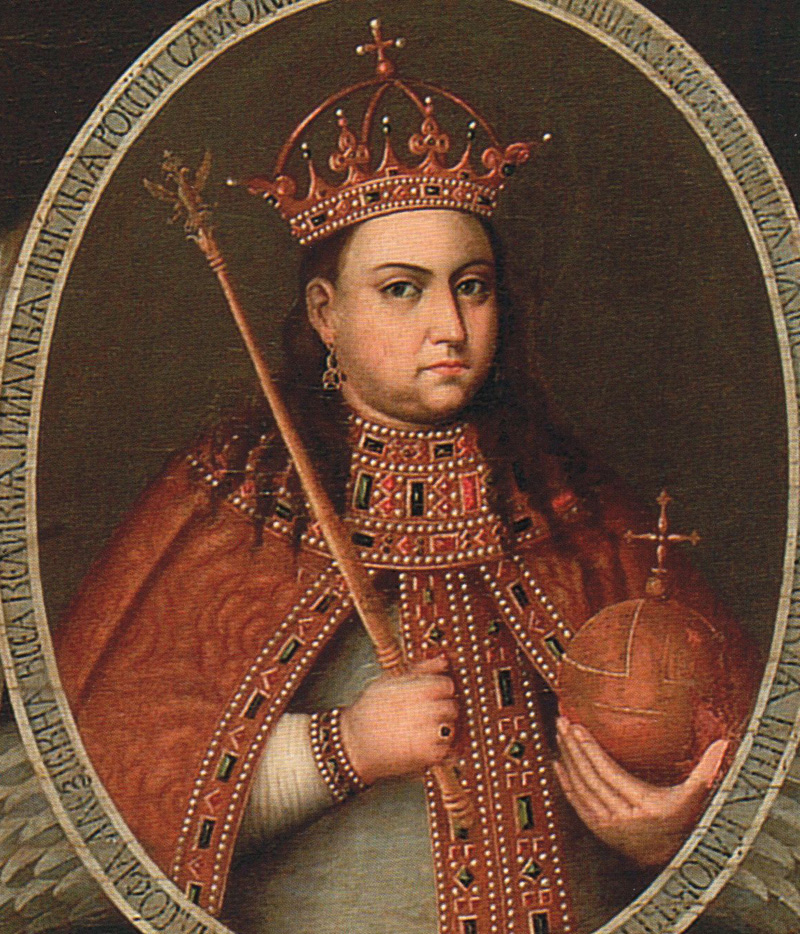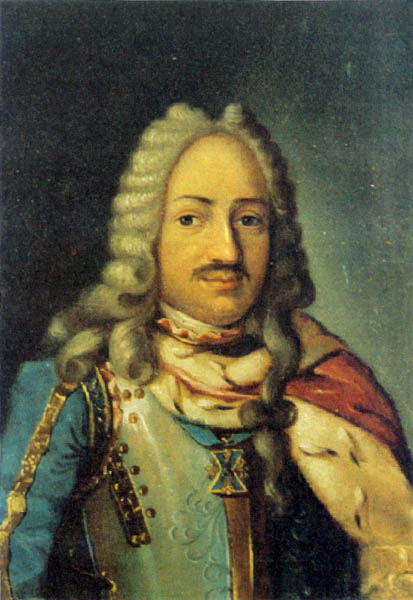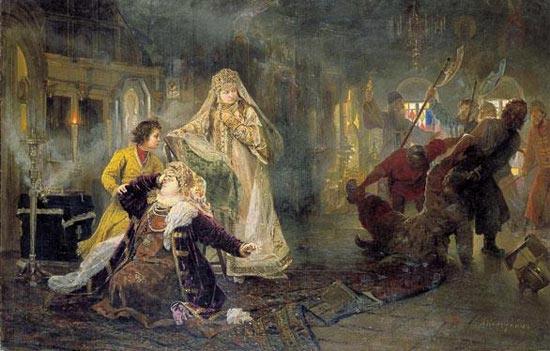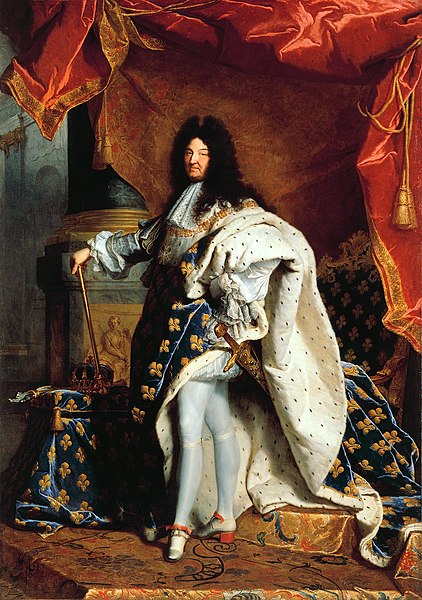 |
| Sophia as Regent |
Their
success at forcing Ivan onto the throne and making Sophia Regent led the
Streltsy to believe that their slightest whim would now be honoured. The Old
Believers[i] thought that the Streltsy
would support the return of the old liturgy and rituals. Sophia, like her
brother Feodor and her father, saw the Old Believers as rebels and she wooed
the Streltsy, bribing them with money and drink, in groups of circa one hundred
at a time.
When the
Streltsy were in her pocket the leaders of the Old Believers were arrested; one
was executed and the remainder exiled. Prince Ivan Khovansky[ii], one of Sophia’s advisers but also
one of the fervent Old Believers, was one of those executed. This struggle
between old and new within Orthodoxy was to continue throughout the lifetime of
the Russian Empire.
One of
Sophia’s first acts as regent was to place her own men in key positions; but
her principal adviser was her lover Prince Galitzyne. Galitzyne hoped to
transform the Russian army, establish permanent relations with the West,
proclaim freedom of worship and even, most heretical of all, freeing the serfs.
Galitzyne prided himself on administering;
‘A reign based on justice
and general consent.’[iii]
Sophia as a woman was expected to stay out of politics and hide in the terem. Instead she hid
behind the public personae of Ivan and Peter and Galitzyne. In private she
ruled.
Prince Galitzyne
During the
Regency domestic difficulties increasingly diverted attention away from the
western veneer Galitzyne had been encouraging.. From the beginning Sophia and
Galitzyne had been determined on a peaceful foreign policy to enable freedom of
action at home. The war against the Tartars resulted in a freezing of domestic
reform.
Peter and Ivan
While Sophia
was able to rule the country on her own, there were occasions when she was
unable to dispense with Ivan and Peter’s attendance at ceremonial occasions; state
banquets, religious festivals, and receiving foreign ambassadors. In 1683 the
two Czars received the Swedish ambassador.
‘Both their Majesties
sat……….on a silver throne like a bishop’s chair, somewhat raised and covered
with red cloth. The Tsars wore robes of silver cloth woven with red and white
flowers…………the elder drew his cap down over his eyes several times and, with
looks cast down on the floor, sat almost immobile. The younger had a frank and
open face………..He constantly looked about, and his great beauty and lively
manner………..struck all of us so much that had he been an ordinary youth and no
imperial personage we would gladly laughed and talked with him.’[iv]
Peter was
now so tall that the ambassador took the eleven year old for sixteen. The half brothers
were kept separate, but they did manage under these difficult circumstances to
retain a loving relationship. The Dutch ambassador wrote home to say that
‘The natural love and
intelligence between the two Lords [Ivan and Peter] is even better than before.’[v]
Praskovia Saltykova
Ivan and
Feodor had called Natalya mother, since her marriage to their father. To ensure
the continuation of their rule Sophia and advisers decided that the sickly
Ivan, whose life span was likely to be short, should marry. His wife presented
him with a daughter each year from 1689 to 1691; there was a gap in 1692 and
then in 1693 and 1694 Praskovia Saltykova presented Ivan with two more daughters[vi].
Peter’s War Games
To escape
the oppressive atmosphere in the Kremlin, Peter and Natalya moved to live at
Alexis’ favourite villa and hunting lodge at Preobrazhenskoe; about three miles
outside Moscow. Here, in the fields and woods, Peter could play his favourite
game – WAR. For his games Peter drew on the government arsenal to supply his
needs. On his eleventh birthday Peter had real cannon to fire the salute.
Peter had
playmates to join in his games. As he
grew older his father’s servants and their families and the scions of noble
families were enrolled in Peter’s little force, which eventually numbered
around three hundred. Peter declined to rule this little army; originally he
took the rank of drummer boy, eventually promoting himself to artilleryman.
This was to enable him to fire the cannon.
In the
barracks, built especially for this mini-army, Peter accepted the same rules as
his fellows, performing the same duties, slept in the same tents and stood
watch or digging trenches. This refusal to start at the top was characteristic
of the man too, who never accepted a promotion in the armed forces unless he
felt he deserved it. Peter firmly believed in learning from the bottom up.
In 1685 the
little army began to construct a fort from the ground up. Once completed Peter
blew it up, just to see if he could. Peter used specialists to advise him and
these specialists were usually foreigners. The foreigners normally arrived as
temporary instructors; but by the time in the early 1690’s when two regiments[vii] were formed from the boy
army, many of the foreigners became officers in the new regiments. Sophia
occasionally loaned regiments of the Streltsy to join in the war games.
Peter and the Boat
Peter was
fascinated by all and everything; he learnt stonemasonry, carpentry,
bookbinding, wood and ivory turning and blacksmithing. Once at Preobrazhenskoe
Peter dispensed with a formal education. He read few books, his handwriting was
atrocious and he learnt no foreign languages[viii]. As an adult Peter was
to regret this lack of a formal disciplined education.
In 1687 the
chance mention of a strange foreign measuring instrument[ix] led to Peter being bought
a sextant and Peter then found a Dutch merchant who knew how to use the
instrument. Franz Timmerman was to become very important to Peter; insisting
that he could not teach Peter how to use the sextant without certain basic
skills. Peter now turned his attention to arithmetic, geometry and ballistics.
The botik of Peter the Great
Timmerman
was often with Peter and it was in June 1688 when Timmerman and Peter were
strolling through a royal estate that the pair came across the decaying remains
of a boat. It was an English boat that
Timmerman assured Peter could sail against the wind[x]. Peter ordered the major
repairs needed to make the boat seaworthy; these were done under the
supervision of another Dutchman Karsten Brandt. Peter became enamoured of
sailing and set up a boat builder’s yard on Lake Pleschev, using the skills of
his Dutch advisers.
As Czar,
Peter was to continue the use of foreign expertise in his attempts to drag
Russia into the eighteenth century. And he was to remain fixated on sea power.
In the Crimea
I
In 1685 the Turks defeated the Poles and the spring of 1686 saw a Polish embassy arrive in Moscow, seeking an alliance against the Sublime Porte. Poland formally ceded the ancient city of Kiev to the Russians and in return Sophia agreed to attack the Khan of the Crimea[xi]; a decision that was to cost her dear. The agreement with the Poles required a reversal in the previously friendly relations between the Ottomans and the Russians.
Jan Sobieski, King of Poland
n 1683 the
Ottoman army camped before the gates of Vienna; it was the Polish king Jan Sobieski who led the Christian forces to victory. The majority of
European rulers were more concerned about the might of France, so Poland and
Austria were eager to persuade Russia to support the fight against the
heretical Turks.In 1685 the Turks defeated the Poles and the spring of 1686 saw a Polish embassy arrive in Moscow, seeking an alliance against the Sublime Porte. Poland formally ceded the ancient city of Kiev to the Russians and in return Sophia agreed to attack the Khan of the Crimea[xi]; a decision that was to cost her dear. The agreement with the Poles required a reversal in the previously friendly relations between the Ottomans and the Russians.
The Crimean
Tartars had long been a thorn in the Russian side; many Tartar raids took
Russians off to sell in the slave markets of Istanbul. In May 1687 a Russian
army of 100,000 marched out towards Orel and Poltava. Galitzyne, the army’s
commander, was wary of being outflanked by the Tartars and by June 13th
was camped on the bank of the Dnieper river.
The Tartars
were meanwhile setting fire to the steppes, to deprive the invading Russians of
forage for their horses and at times the army was engulfed in smoke, choking
both men and animals. By August the army was in retreat. On his return to
Moscow Galitzyne described his campaign as a success and was hailed as a hero
by his lover. The reality was soon apparent.
In 1688
matters worsened for the allies. Louis XIV attacked the Hapsburgs in Germany.
And in mid 1688 the Tartars ravaged the Ukraine, returning home with nearly
60,000 victims for the slave markets. The Poles and the Austrians were
seriously considering coming to terms with the Turks. The only factor that
would change their minds was a further attack in the Crimea by the Russians.
Faced with the possibility of returning Kiev to the Poles, Sophia and Galitzyne
agreed to a second campaign.
Galitzyne
announced the second campaign. He was under attack from personal and political
enemies in Moscow, who were able to ensure that he commanded this fiasco too.
The campaign was once again a failure, but this was not how it was reported in
Moscow. Sophia hailed Galitzyne as a hero again, writing to him;
‘Oh my joy, light of my
eyes, how can I believe my heart that I am going to see you again, my love.
That day will be great to me when you, my soul, shall come to me. If it were
only possible for me, I would place you before me in a single day.’[xii]
However
François Lefort, a Swiss officer in the Russian army, wrote home;
’20,000 killed and 15,000
taken prisoners. Besides that, seventy cannon were abandoned, and all the war
material.’[xiii]
On July 8th,
breaking with protocol, Sophia met Galitzyne at the gates of Moscow and
Galitzyne was received and publicly thanked by Ivan and the Patriarch.
Peter
declined to play in this charade, forced to agree to reward Galitzyne, he
refused to meet with him, as protocol demanded, when Galitzyne attended
Preobrazhenskoe to thank the Czar for his generosity one of the senior foreign
officers, General Patrick Gordon noted;
‘Everyone saw plainly and
knew that the consent of the younger Tsar had not been extorted without the
greatest difficulty and that this merely made him more excited against the
generalissimo and the most prominent members of the other party at court; for
it was now seen that an open breach was imminent.’[xiv]
Bibliography
Natasha’s
Dance – Orlando Figes, Penguin Books Ltd 2002
Russia and
the Russians – Geoffrey Hosking, The Penguin Press 2001
Peter the
Great – Robert K Massie, Abacus 1992
www.wikipedia.en
[i] The Orthodox religion had
been split, those who wanted change and those who wanted to turn the clock back
[ii]
Sophia had appointed him as the new commander of the Streltsy
[iii]
Peter the Great - Massie
[iv]
Ibid
[v]
Ibid
[vi]
Females were unable to inherit the throne
[vii]
The Preobazhensky and Semyonovsky Regiments
[viii]
Apart from a smattering of German and Dutch on his trip to Europe.
[ix]
Russia was still very much medieval in outlook and habit
[x]
Something no Russian boat was capable of doing
[xi]
A vassal of the Ottoman Empire
[xii]
Peter the Great - Massie
[xiii]
Ibid
[xiv]
Ibid





.jpg)



